Talker/80 for the Model I, III, and 4
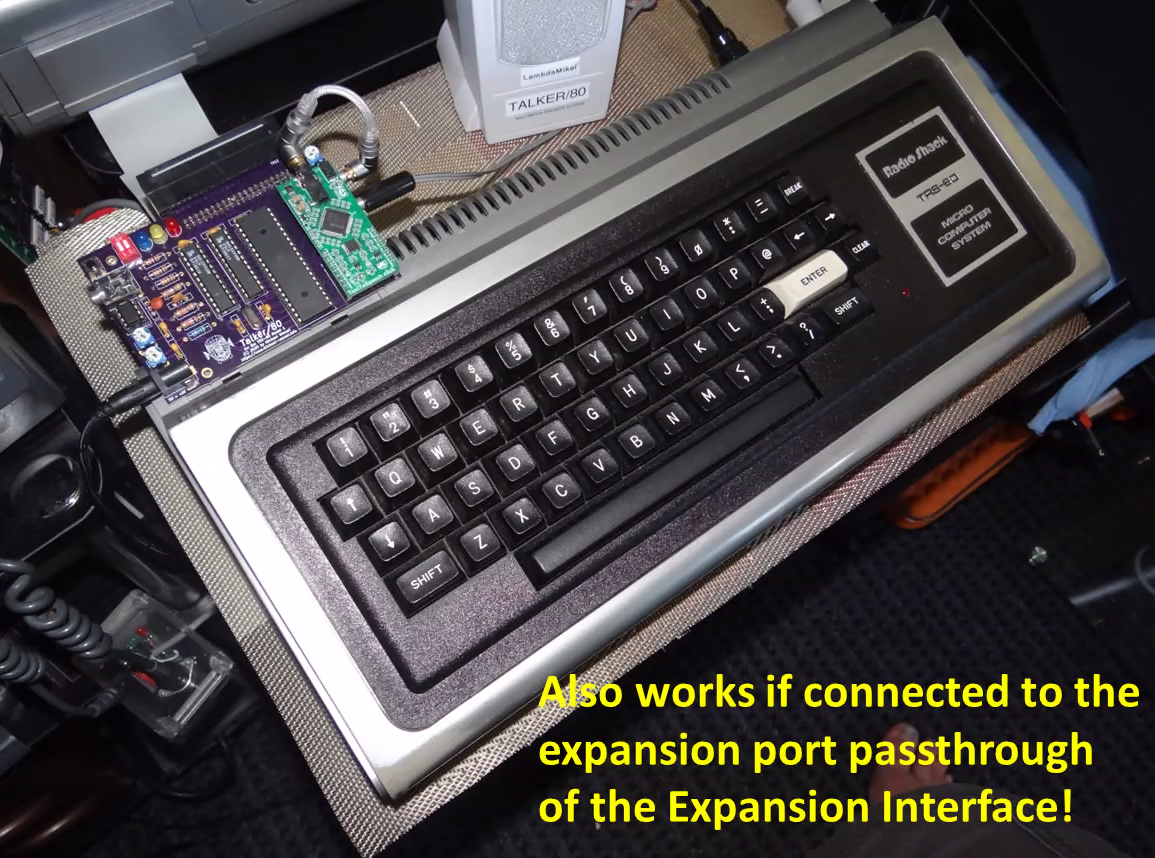
Attached to Model I
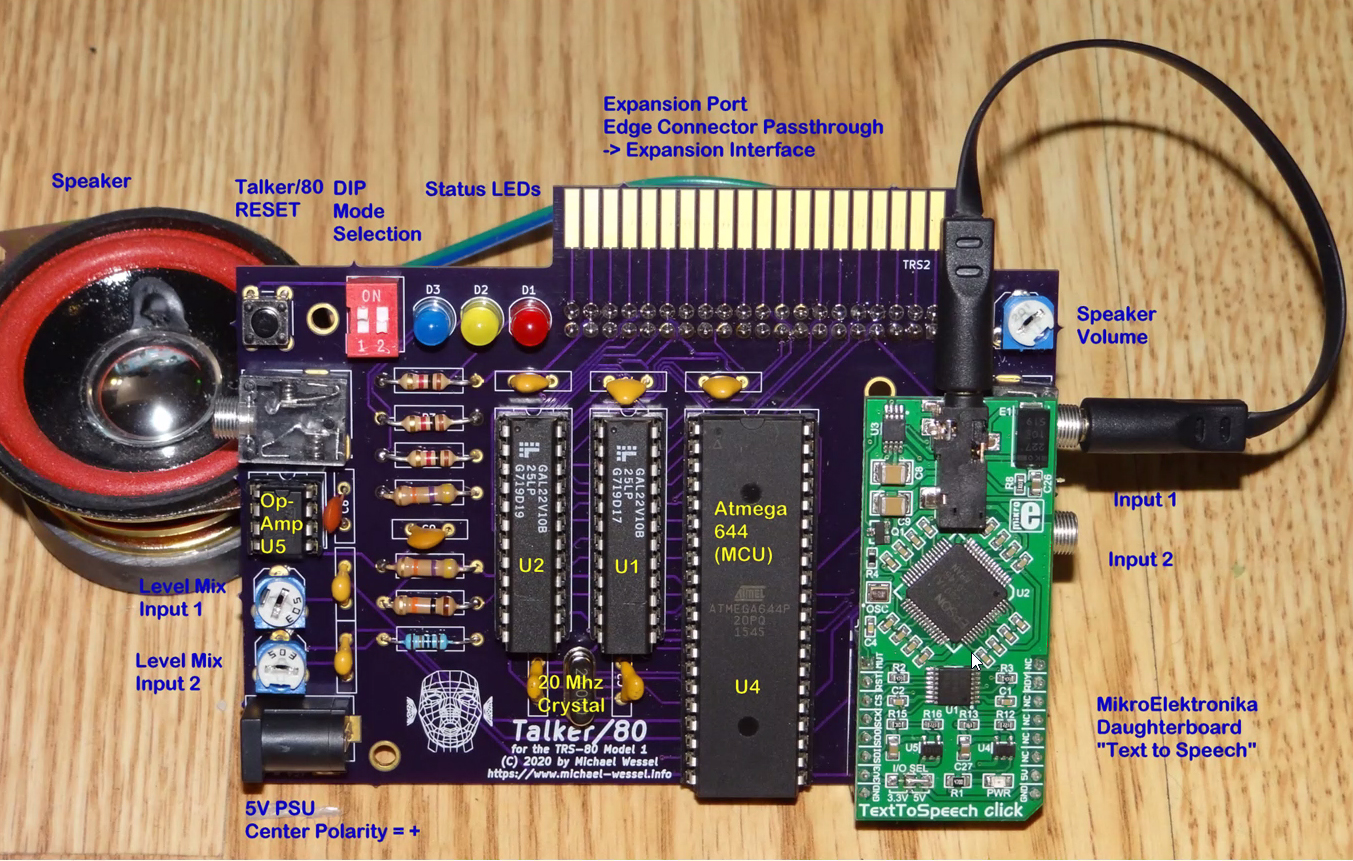
Model I Board

Model III/4 Board
Michael Wessel has developed the Talker/80, a new Voice Syhtesizer for the Model I, III, and 4. It has natural sounding speak (like Alexa), requires no machine language driver, and has an E/I passthrough so it will work with a E/I, FreHD, and Quinterface.
The Talker/80 emulates the TRS-80 Voice Synthesizer and the VS-100.
The Talker/80 is open source under the GPL3 License and is maker-friendly (no surface mount soldering and easy to acquire parts). See:
- Github Repository to make your own
- Video on assembling for the Model III/4
- Search eBay for already built boards
NEWPRINT/Multi
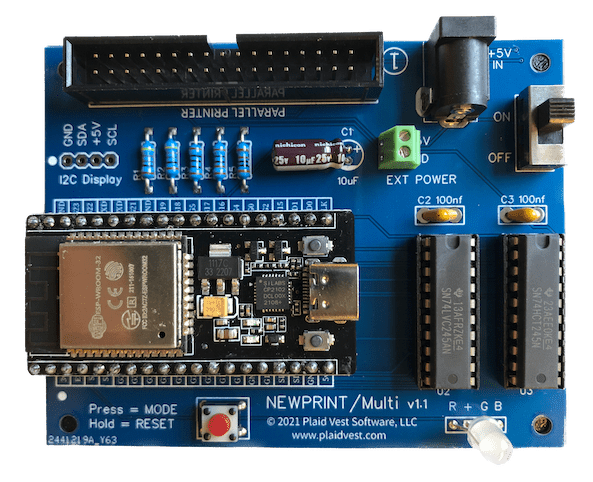
Click to Enlarge
The NEWPRINT/Multi is a Virtual Wi-Fi printer with web-browser output for all TRS-80 models.
Requirements
- Wi-Fi requires a 2.4Ghz network. 5Ghz is not supported
- Power adapter (+5v DC) USB-C or standard barrel connector
Limitations
- TRS-80 is text only
Details
- NEWPRINT/Multi is a Wi-Fi-enabled “virtual” printer adapter that connects to your computer’s printer port and your local Wi-Fi network to send printer output to any device that supports a modern browser (iPad, Desktop PC, Mac, etc.).
- The NEWPRINT web interface can show printer output as plain text, hexadecimal values, Print Shop graphics (Apple II), or Apple IIgs GS/OS graphics printing.
- Text mode output does not (currently) understand special printer control codes used by most word processors (BOLD, multiple font sizes, Form Feed, etc.).
- The NEWPRINT web interface is available from any browser on your local Wi-Fi network at newprint.local
- NEWPRINT uses the standard HTML WebSocket API so you can even write your own web-based or desktop interface for displaying and processing NEWPRINT output.
- Note: A power adapter (+5v DC) and printed User’s Manual are not included to keep prices low. See the PDF User’s Manual below for more information.
Visit https://www.plaidvest.com/newprint.html for more details and for ordering.
Newkey Ultra
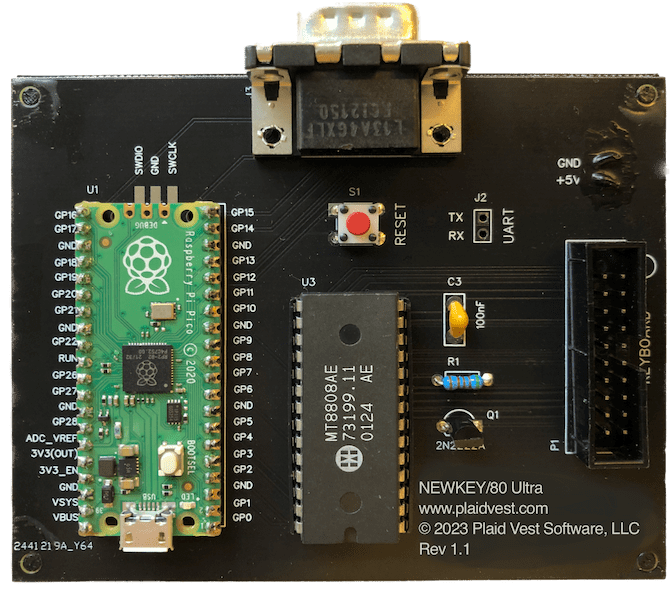
Click to Enlarge
The USB Keyboard and Joystick Adapter for TRS-80 Model III/4.
Compatibility
- TRS80 Model 3 or 4
Why NEWKEY/80 ?
- Replace your broken or poorly functioning keyboard
- More familiar PC keyboard layout
- Play games using an Atari Joystick!
- Accurate key response with no ghosting or keybounce
- Multi-key shortcuts for DOS functions (DFG, JKL, etc.)
- Multi-key mode for advanced key handling
- Use your favorite USB keyboard (wired or wireless) on your TRS-80
Features
- Compatible with most standard USB keyboards
- Also works with wireless 2.4Ghz USB keyboards
- Atari-compatible 9-pin joystick port
- Compact size. Mounts inside TRS80 case.
- Can work simultaneously with existing keyboard
- Fast and accurate key response without keybounce or ghost characters
- Native TRS-80 key repeat
- Handles special keys independently (arrows, space, control, break, shift, @) for excellent compatibility
- Works great with games and applications
- Supports TRS80 control and multi-key sequences
- Easily upgradable firmware to allow for enhancements and bug fixes
Notes
- NEWKEY/80 mounts inside the TRS80 case. This is a fairly easy process but does require +5v and ground connections. A 4-pin Molex Disk Drive power splitter cable and a plain 2-wire power connector are included.
- Wireless keyboards need to be the “no drivers required” 2.4Ghz type
- A USB keyboard extension cable (not included) can be used to route the keyboard connector outside of the TRS80 case (not needed when using a wireless keyboard).
- A common 9-pin D-Sub or Atari joystick extension cable (not included) can be used in a similar fashion to route the joystick connector outside of the TRS80 case.
Visit https://www.plaidvest.com/newkey80.html for more details and for ordering.
High-Res Graphics to a Model 4/4GA/4D
Ian Mavric has developed a High-Res Graphics board for the TRS-80 Model 4/4GA/4D. It is compatible with the microlabs GX 4.2 board and can be ordered for the cost of $179.99 plus shipping.
TRSNIC for Model III/4
TRSNIC is a WiFi TCP/IP network interface for the Model III and Model 4.
Details can be found at this GITHUB.
TRS-IO for Model III

Click to Enlarge
TRS-IO gives a 48K TRS-80 Model III online capabilities and provides access to a variety of services. TRS-IO currently features the following capabilities:
- Access to the RetroStore
- FreHD emulation – Not to be used in conunction with FreHD
- Access to files mounted on a SMB share
- Access to remote servers via TCP
Information on the TRS-IO can be found at https://github.com/apuder/TRS-IO.
MISE v1.2 for the Model I
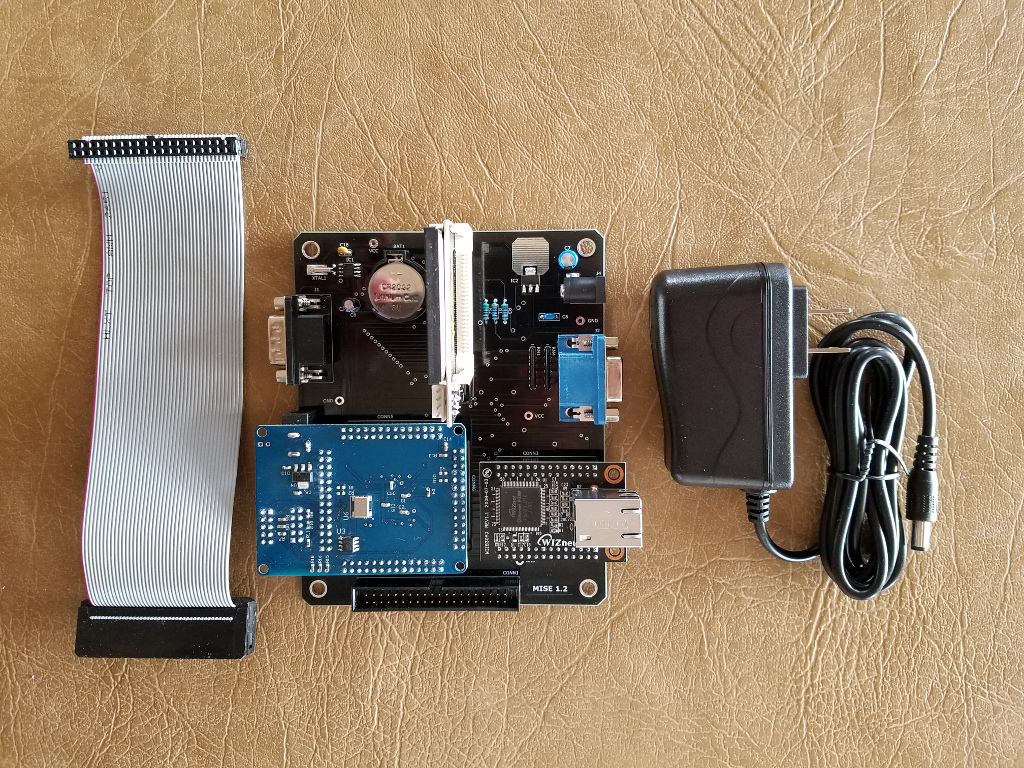
Click to Enlarge
The MISE (Model I System Expander) is an add-on device for the vintage Radio Shack TRS-80 Model I microcomputer. It connects to the buffered expansion port on the Expansion Interface or directly to the Model I keyboard, and provides these benefits:
- Direct-booting solid state hard disks on Compact Flash, with LDOS-5.3.1 preloaded. No boot floppy or ROM modification is required. Each bootable image can hold up to 64MB, and multiple images on CF cards are supported. That’s a whole lot of space for programs mostly written for 16KB RAM. Dual CF cards can be used for additional storage or easy backup.
- 10/100 Mbps wired Ethernet connection (up to 8 active IP sockets) with included software: FTP and TFTP servers, FTP client, DHCP client, SNTP client, Telnet client, and Telnet server and DNS client demo programs. Globally-unique MAC address (EUI) provided. Easily move files to and from your TRS-80! Drag and drop!
- Real-time clock/calendar with battery backup, compatible with the vintage Alpha Products Newclock-80. Battery backup means the date and time will be accurate and automatically set at every system boot.
- Crystal-clear SVGA display output for an 800×600 @ 60Hz monitor, no software required. One-of-eight selectable foreground, background, and border colors. Emulation of the vintage high-resolution PCG-80 and 80-Grafix devices. 80-column text display mode available. Using the VGA display is optional; you can still use the original CRT monitor if you prefer, or you can even use both at the same time.
- ROM extension including drivers for the hard disks, real-time-clock, and double-density floppy adapter, if you have one. None of these drivers need consume precious high memory.
- Joystick port for Atari 2600 compatible joysticks. Works with most vintage Model I games.
- 256-byte general10-purpose Flash EEPROM for persistent storage.
- Last updated March 26, 2019.
The manual, set-up instructions, software, and far more information (including ordering) can be found at http://bartlettlabs.com/MISE/.
M3SE v1.1 for the Model III/4/4D/4P

Click to Enlarge
The M3SE (Model III System Expander) is an add-on device for the vintage Radio Shack TRS-80 Model III, Model 4, Model 4D, and Model 4P microcomputers. It connects to the buffered expansion port, and provides these benefits:
- Solid state hard disks on Compact Flash, with LDOS-5.3.1 and LS-DOS 6.3.1 preloaded. An included boot floppy is required except for the TRS-80 Model 4P, which auto-boots from the hard drives. Each bootable image can hold up to 64MB, and multiple images on CF cards are supported. Dual CF cards can be used for additional storage or easy backup.
- 10/100 Mbps wired Ethernet connection (up to 8 active IP sockets) with included software: FTP and TFTP servers, FTP client, DHCP client, SNTP client, Telnet client, and Telnet server and DNS client demo programs. Globally-unique MAC address (EUI) provided. Easily move files to and from your TRS-80! Drag and drop!
- Real-time clock/calendar with battery backup, compatible with the vintage Alpha Products Newclock-80. Battery backup means the date and time will be accurate and automatically set at every system boot.
- Crystal-clear text-only SVGA display output for an 800×600 @ 60Hz monitor. 80-column text display mode available. Using the VGA display is optional; you can still use the original CRT monitor if you prefer.
- Joystick port for Atari 2600 compatible joysticks. Works with most vintage joystick-enabled games.
- 256-byte general10-purpose Flash EEPROM for persistent storage.
- Works with both “slow” (2MHz) and “fast” (4MHz) CPU clock rates.
- Last updated September 27, 2018.
The manual, set-up instructions, software, and far more information (including ordering) can be found at http://bartlettlabs.com/M3SE/.
Floppy Drive Remapper for the Model III/4/4D/4P by George Hines
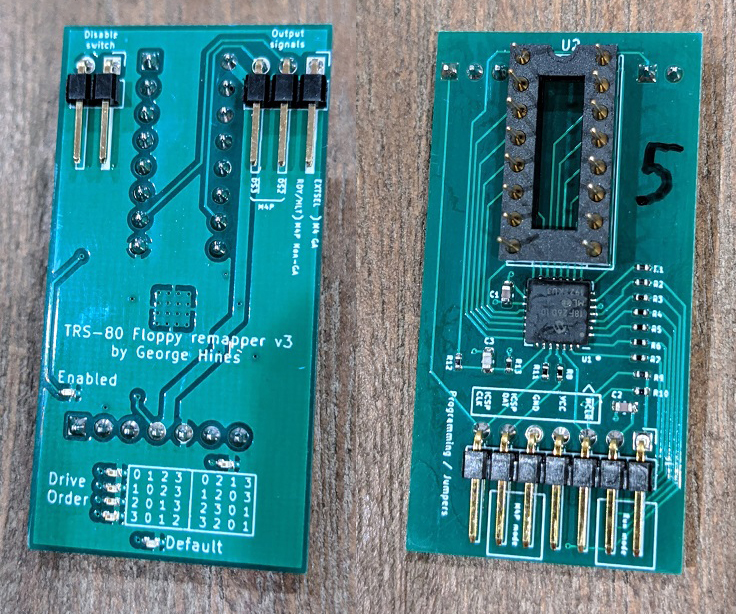
Click to Enlarge
After installation, a switch will allow booting from (and use) external floppy drives as though they were placed internally. This is a convenient way to use a floppy drive emulator or a real floppy (interchangeably) without having to retrofit the case or swap cables each time.
More information can be found at https://github.com/mrthreeplates/TRS-80_floppy_remapper
Orchestra-85 Repro for the Model I by Ian Mavric
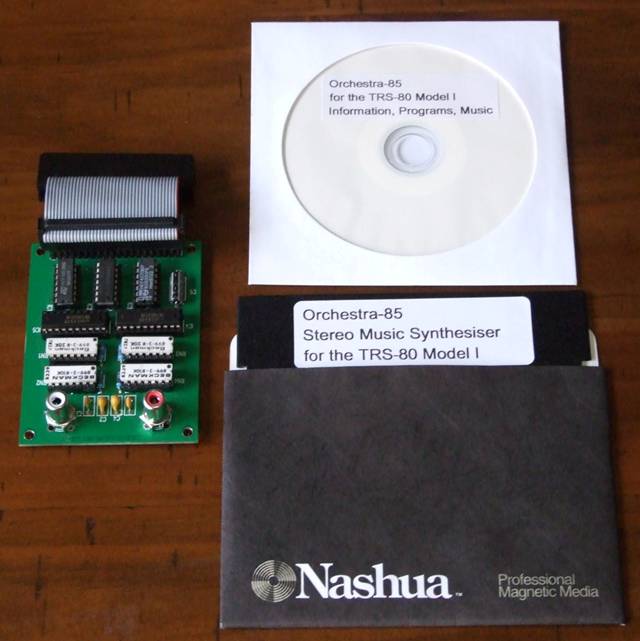
Click to Enlarge
A a stereo music synthesiser with up to six octaves, 5 simultaneous notes (or voices), each of which can be assigned any of five instrumental choices (tone colour registers). Plays old /ORC music files.
More information can be found at http://www.frehd.com.
Orchestra-90 Repro for the Model III/4 by Ian Mavric
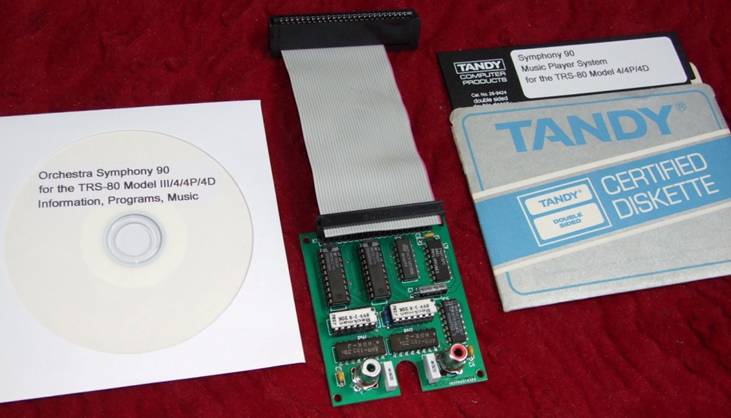
Click to Enlarge
A a stereo music synthesiser with up to six octaves, 5 simultaneous notes (or voices), each of which can be assigned any of five instrumental choices (tone colour registers). Plays old /ORC music files.
More information can be found at http://www.frehd.com.
Question: I see this new graphics board has a 32K byte SRAM, the 62256ALP-10. It is stated to be MicroLabs compatible. The uLab board only had 20 KB of SRAM. But the Radio Shack board had 32K of DRAM. So this brings to mind some questions: 1) is only 20 KB of this new board accessible, as on the uLabs board ? 2) if the full 32K is accessible, is this implemented as on the Radio Shack board ?
To refresh our memories, recall that the Radio Shack board’s 32K RAM was organized as 128 bytes per horizontal rows, with 256 rows in total. Hence 128 bytes/row * 256 rows = 32 KB DRAM. Yes?
uLabs SRAM was organized as 80 bytes/row * 256 rows = 20 KB SRAM. Yes?
(or did uLabs create a new board of which I am unawares?)
Just checking…my memory is a little hazy going 30+ years back!
jeffrey_josph@yahoo.com
I am doing a major cleanup and found a 1981 Tandy modem, I remember buying it at a governemnt of Canada asset sale. It is a circuit board but no case. The bottom of the board has this: PCP -86V-0 8709227 REV A TANDY CORP 1981. i Can’t find anything thrugh google.